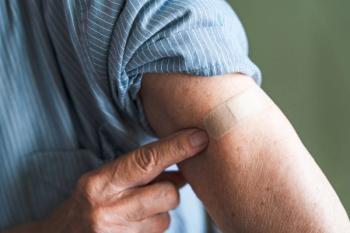
Two-Dose HepB Vaccine Not Associated With Increased Risk of Acute MI
The 2-dose hepatitis B vaccine was not associated with a higher risk of acute myocardial infarction compared with the 3-dose hepatitis B vaccine series.
According to the CDC, hepatitis B virus (HBV) affects approximately 296 million individuals globally.1 This includes over 6 million children under 5 years of age.1 Hepatitis B is a serious liver infection caused by HBV, and every 30 seconds, an individual dies from a hepatitis-related illness.2
The Advisory Committee on Immunization Practices (ACIP) recommends that the following individuals receive HBV vaccination3:
· All infants
· Unvaccinated individuals younger than 19 years of age
· Adults 19 to 59 years of age
· Adults 60 years and older with HBV risk factors
The goal of the World Health Organization is to eliminate hepatitis B by 2030. A white paper published by the World Hepatitis Alliance includes recommendations to prevent mother-to-child transmission,4 such as testing in early pregnancy and education provided as a prenatal standard of care.4 The ACIP also issued updated recommendations in 2022 that individuals 60 years and older without HBV risk factors may also receive the vaccine.5 The recommendations emphasize that health care providers should offer the vaccine to this population instead of waiting for patients to request it.5
The HBV vaccine with a cytosine phosphoguanine adjuvant (HepB-CpG vaccine; Heplisav-B) is a 2-dose vaccine series approved for adults 18 years and older.6 In clinical studies, Heplisav-B was found to produce greater seroprotection than the 3-dose HBV with an aluminum hydroxide adjuvant (HepB-alum vaccine; Engerix-B).6 Engerix-B is approved for vaccination at birth and for pediatric and adult patients.6 One previous clinical trial reported a higher number of acute myocardial infarction (MI) events in patients receiving Heplisav-B (0.25%) than those vaccinated with Engerix-B (0.04%).6 Heplisav-B was approved in 2017, and the FDA required a postmarketing study to evaluate the risk of acute MI.6
Hepatitis B Vaccine and Acute MI
The postmarketing study was conducted at Kaiser Permanente Southern California (KPSC) to compare the acute MI rates between individuals receiving Heplisav-B and Engerix-B.6 The prospective cohort, noninferiority study used a nonrandomized cluster design to distribute the HBV vaccines to the KPSC medical centers.6 Individuals included in the study were at least 18 years or older.6 These individuals must have received at least 1-dose of HBV vaccine from August 7, 2018 to October 31, 2019 during a family medicine or internal medicine visits. Additionally, this was the timeframe and setting where more than 90% of HBV vaccine were administered.6 Patients undergoing dialysis were excluded from the study.
Study participants were monitored through the electronic health record system for 13 months. There were 31,183 patients included in the Heplisav-B group and 38,442 study participants in the Engerix-B group.6 The median age in both groups was 49 years.
There were 74 potential acute MI events that occurred in the Heplisav-B group and 128 in the Engerix-B group during the study follow-up period.6 Additionally, 52 events were classified as type 1 acute MIs (definite or probable) in the Heplisav-B group.6 There were 71 events considered type 1 acute MIs in the Engerix-B group.6 Additionally, the rate per 1000 person-years of type 1 acute MI was 1.67 in the Heplisav-B group and 1.86 in the Engerix-B group.6 An analysis was performed comparing the incidence of type 1 acute MI between the groups. The Kaplan-Meier analysis (survival analysis) found that the cumulative incidence of type 1 acute MI events was similar between groups (P =.56).6
The investigators pointed out several study limitations, such as the possibility of misclassification of the vaccine exposure.6 However, manufacturer and lot number information were checked against the brand name. Additionally, chart reviews of the doses were also performed. Possible misclassification of acute MI was also a limitation, but two cardiologists reviewed all the data.6
The study investigators concluded that there was not an increased risk of acute MI with the Heplisav-B vaccine compared with the Engerix-B vaccine.6 These results were consistent across all subgroups defined by age group, diabetes, hypertension, receipt of concomitant vaccines, and whether the index dose (first dose during the study period) was the first or subsequent HBV vaccine.6
References:
1. Fast facts on global hepatitis B. CDC. Updated July 27, 2022. Accessed February 27, 2023. https://www.cdc.gov/globalhealth/immunization/diseases/hepatitis-b/data/fast-facts.html
2. World hepatitis day 28 July. World Hepatitis Alliance. Reviewed March 30, 2022. Accessed March 3, 2023. https://www.worldhepatitisday.org/
3. Hepatitis B questions and answers for health professionals. CDC. Accessed February 27, 2023. https://www.cdc.gov/hepatitis/hbv/hbvfaq.htm
4. Mothers and babies can’t wait: A call for action to end mother-to-child transmission of hepatitis B. World Hepatitis Alliance. Accessed March 3, 2023. https://www.worldhepatitisalliance.org/news/pmtctreport/
5. Weng MK, Doshani M, Khan MA, et al. Universal Hepatitis B Vaccination in adults aged 19–59 years: Updated recommendations of the Advisory Committee on Immunization Practices—United States, 2022. MMWR Morb Mortal Wkly Rep 2022;71(13):477-483. doi: 10.15585/mmwr.mm7113a1
6. Bruxvoort K, Slezak J, Qian L, et al. Association between 2-dose vs 3-dose hepatitis B vaccine and acute myocardial infarction. JAMA. 2022;327(13):1260-1268. doi: 10.1001/jama.2022.2540
Newsletter
Pharmacy practice is always changing. Stay ahead of the curve with the Drug Topics newsletter and get the latest drug information, industry trends, and patient care tips.

















































































































